Globalization is a phenomenon that impacts countries around the world. During our time in Thailand, we have been able to identify some of the issues in this country, especially in comparison to our own country. Specifically, we have seen common threads regarding globalization including issues with the environment, tourism, public and private health, and culture and identity.
The people of Thailand are completely immersed in the environment of Thailand. In the hot and humid weather of the jungles, Thai people take full advantage of the land that they have. On May 25th, we went to an NGO called the Hill Area Development Foundation (HADF). One of the objectives of this organization is to protect the environment and natural resources that are in Thailand. We learned that deforestation is a growing problem in Thailand because they are making more land for cash crops that get exported to other countries. It is disheartening because these pieces of land are not protected by the local people. Cash crops are a component of globalization that seemingly impacts countries all over the world. People in our society today care more about economy and making profit, rather than respecting the earth that we live in. Alongside the issue of deforestation, there has been a decline in the biodiversity of the environment and an uprising in chemical use with agriculture. The biodiversity of the land here runs parallel to deforestation because as more plants and trees are cut down, it changes the entire ecosystem. Because of these issues, the Thai people, especially in rural areas, are suffering. As we learned about in the Huay Hea village, the villagers have to rent pieces of land, rather than just being able to own it. They pay 500 Baht per 2.5 acres of land. As a citizen in America, it is easy to see the similarities in both countries. We struggle with the same issues. Seemingly, there is not a way to conserve our environment while keeping a strong economy. These variables are intertwined with one another and globalization is a factor in the problem. The higher the demand of goods, the more the environment will suffer unfortunately.
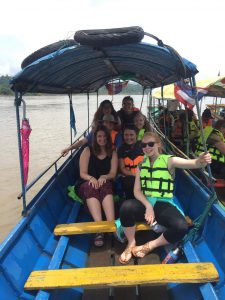
By Callie
As we learned at the Mekong School, Thailand has made many strides in triaging the impacts of globalization on the environment. They are educating the community on water conservation, the history of the river, and more. Instead of taking advantage of the river negatively, they are working towards education. Education as explained, is an incremental part in helping people understand conducive ways to treat and use the environment.
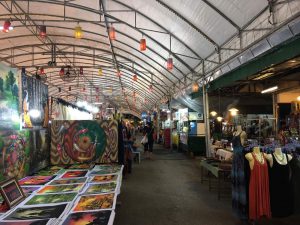
The Thai culture is very rich and unique, from the food, music, tuk tuks, and night markets. Thai culture is heavily influenced by Western culture though, despite being the only Southeast Asian country that has never been colonized by the Europeans or Americans. Western influence is seen in Thai advertisements and products that cater to Western standards. During our stay in Thailand, I (Kia) noticed that many beauty and convenience stores sell skin whitening beauty products.

By Kia
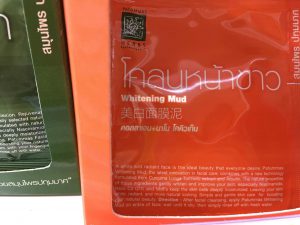
By Kia
Thai people have traditionally believed that lighter skin is more beautiful and represents wealth. Lighter skin means that you have less exposure to sunlight; thus, you don’t do extraneous labor such as farming. With the impact of Thailand’s surrounding countries being colonized in the past and Western beauty standards (high nose bridge, double-lidded eyes, white skin, being tall, etc) dominating the world as what’s ideal, having white skin is even more sought after by Thai people. In addition, a lot of Thai brands and advertisements are in English. Many schools also require their students to learn English. The westernized advertisements and products in Thailand, along with learning English in Thai schools, demonstrate that Thai people think Western culture is more appealing. This shows how much the Western world has impacted other countries through colonialism and white power.
Another aspect of cultural globalization in Thailand is the influence of Thai culture on racial minority groups who reside in Thailand. Because these racial minority groups assimilate into the Thai culture, it is difficult to retain their own culture. Many younger generations go through an identity crisis as they experience living in between two different cultures– the one that they are born with and the one that they grow up with. Even though many of these minority groups have been residing in Thailand for decades, they face racial discrimination and most individuals do not have Thai citizenship. When our class visited HADF, we learned that it is an incredibly hard and long process for stateless peoples to gain Thai citizenship. Ethnic minority children who are born in Thailand must also wait 15 years to gain Thai citizenship. The Thai government feels that this is the length of time needed for ethnic minority children to become fully accustomed to the Thai culture. Furthermore, students who don’t have Thai citizenship, known as G students, are renamed at school with a Thai name. Our class visited the Mekong School in Chiang Khong, where we learned that Thai schools mostly focus on teaching the history of Bangkok and Thai people, less on the history of other small cities and ethnic minority groups. These are just some of the causes that lead to a cultural identity loss. There is a lack of preserving the culture and history of minority groups due to influence of Thai culture.
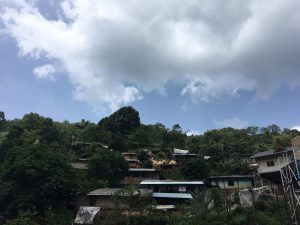
By Kia
The Hmong people is one of the hill tribes groups that this class learned about. The Hmong are a stateless nation who reside in scattered parts throughout the world, mainly in Thailand, Laos, China, Europe, Australia, and America. The Hmong have assimilated to all of these other different cultures. As a Hmong person myself who has assimilated into American culture, it was interesting to see how the Hmong have assimilated into Thai culture. When we visited the Hmong village, Pha Nok Kok, the village chief stated that there are Hmong children who don’t accept their Hmong identity because the Hmong are a marginalized community. I realized that wherever Hmong people are, there is a struggle to understand and accept their Hmong identity. The Hmong culture has overall been affected by globalization.
I (Samantha) feel globalization is the development of international influence in another country, culture, or nation. Coming from a developed country to a developing country as a tourist studying abroad has allowed me to really see the difference, but also the similarities between nations. In the United States there is tourism in all of the major cities. Thailand is similar, but even the villages get tourists. In the U.S.A tourism is more subtle. In Thailand a majority of the tourists are easily identified as not Thai, therefore, I felt it was less subtle. Everywhere our vans go, whether in the U.S.A or Thailand, you can see huge tour busses full of people wanting to experience a different city, country, nation, a different way of life.
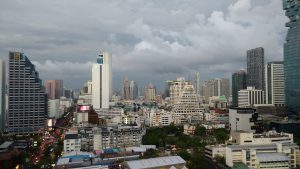
By Sam
Driving through the streets of Thailand we pass Western influence through stores and restaurants like 7 eleven, McDonalds, Starbucks, pizza, KFC and more. Going to the homestay village, Mae Kampong, the influence of coffee was ever present. The coffee shop was the only place in the village with wifi and coffee. The study abroad group spent a lot of time in this location. We played cards, had coffee and it was the meeting spot before all of our daily activities. I couldn’t help but think what it would’ve been like for the two days with our 20 students not having their daily caffeine dose and a place for us all to get together and relax. I found that even in the two days at the homestay, wifi and coffee were very much a western culture need. As tourists came and stayed in the homes, as we did, they wanted to get a taste of living a traditional and culture of the rural Thai way of life.
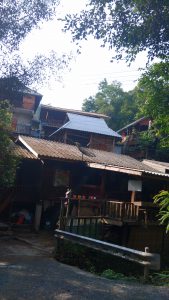
By Sam
In Thailand it is important for villages to keep their culture and traditions. Becoming a more developed country is starting to bring in more tourists because their income can help the country, any country, become more sustainable. In the Mae Kampong village we stayed at, the chief gave us an interview. He developed what I thought to be an amazing system to keep the culture, environment, and traditional way of life. This was all while keeping the village sustainable. His vision became a reality called Cultural Based Tourism (CBT). CBT took 4 years of preparations and has been active for over 10 years. Villagers let tourists into their homes. They cook the meals for their guests, they involved us in their morning donations to the monks, as well as opened businesses like hiking and coffee shops. The money given from tourists goes into a pool. Within this pool the money goes to income, health care, birth, death, and education. The chief wants his people and his culture to strive.
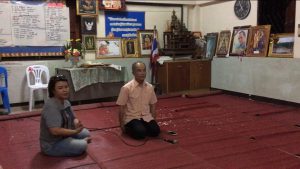
By Sam
The children at Mae Kampong were fortunate to have a village leader and village to try something new and support education. Some youth don’t have as much fortune. Some kids are sold to trafficking, taken or bribed. Some of these children are on the streets, other street children are making money for their families. Tourists have a habit of visiting locations like the market, orphanage, and sometimes sex trafficking locations. We visited a workshop called Child Safe. They teach tourists how to go about with youth in Thailand. Child Safe provides a place where they want to keep children safe and education tourists is a part of that. Tourists will let their empathy show and give a little child money on the street for singing or dancing. What they don’t know is that is keeping the child out of school because they could be making 10 to 15 dollars on the street. Giving to orphanages or playing with the kids is just as bad, causing abandonment issues and more orphans, but giving money or being there. Many of the kids actually have family somewhere. Many are not orphans. The number one thing Child Safe wanted to tell tourists was THINK! How are your actions limiting this individual.

By Sam
There are two types of markets in Thailand, a local one and a tourist one. The tourists ones are jampacked with people trying to buy knock of goods and souvenirs. Local markets have much more handcrafted items. There are silk scarves, hand stitched bags, handmade jewelry and more. However, many tourists don’t buy from these markets which hurts that income of local people because it is their livelihood. As we stopped in a village to visit there would be so many shops and I feel no one walked away empty handed because of the support we wanted to give the village. Even the small villages there was tourism.
Because of the high influx of tourism, there has been an increase in demand for certain fast food and coffee shops. Globalization has impacted the business infrastructure in Thailand because of this increase in demand from tourism. I (Rachel) saw multiple Starbucks and McDonald’s on this trip which leads to increased competition and a decrease in locally owned shops. We talked about this a little bit with a local restaurant owner in Chiang Khong, who was stressing that we had to be patient when a group of seven of us came in for dinner because he and his wife made all of the food fresh and they weren’t like the ‘big chain restaurants’. The powerhouse businesses like Starbucks and McDonald’s expand into new markets with such a strong base that it makes it near impossible for locally owned businesses to compete. The increase in these fast food chains has also had an adverse effect on the health of Thailand’s people, as there is a higher demand for unhealthy snacks.

By Sam
Thailand is full of global influence. We talked a lot about how the U.S.A has an effect on Thailand, but in reality they are influenced from all over. being the only country down on this area that has never been conquered they receive influence from Europe, China, the countries surrounding and more. China has one of the biggest influences in Thailand. Having only three weeks isn’t long enough to really see the depth of how other countries and cultures really affects this one. We only touched a surface of a few global influence and are always looking for more.
